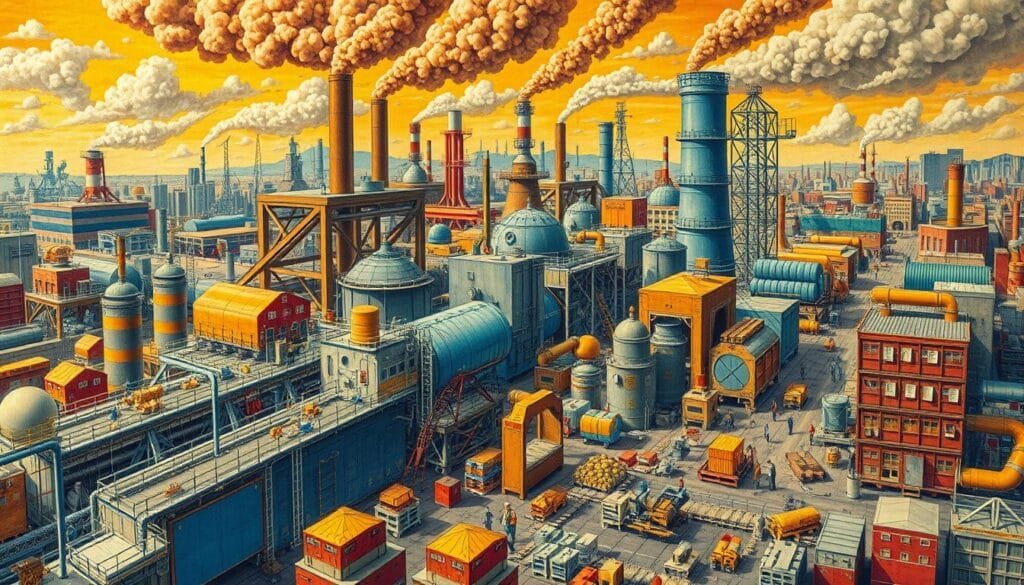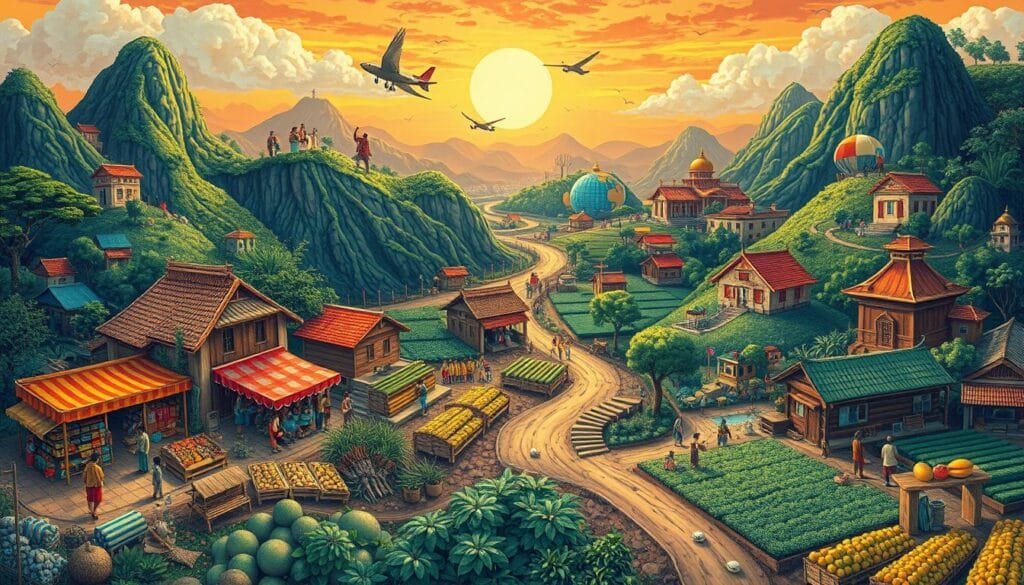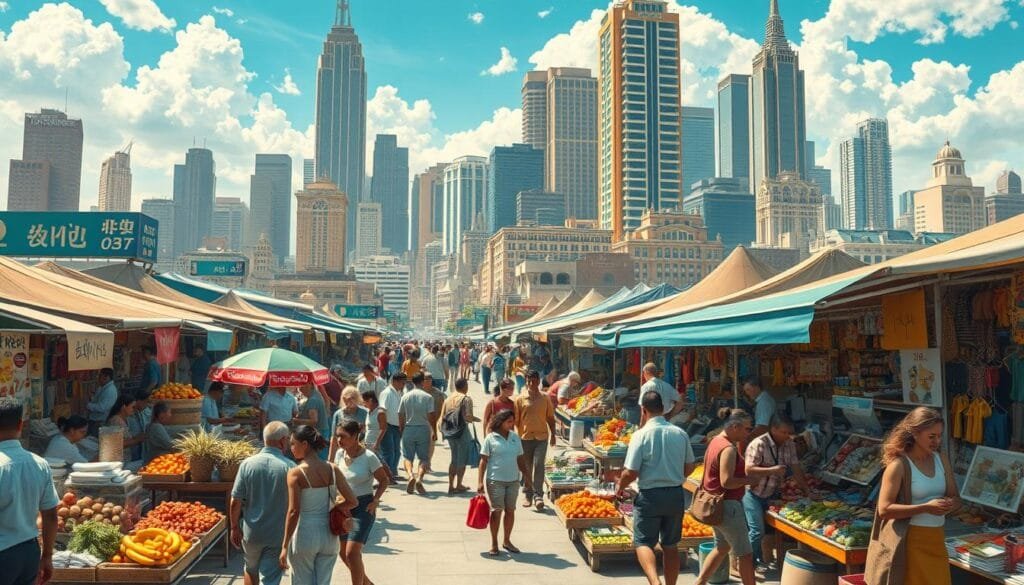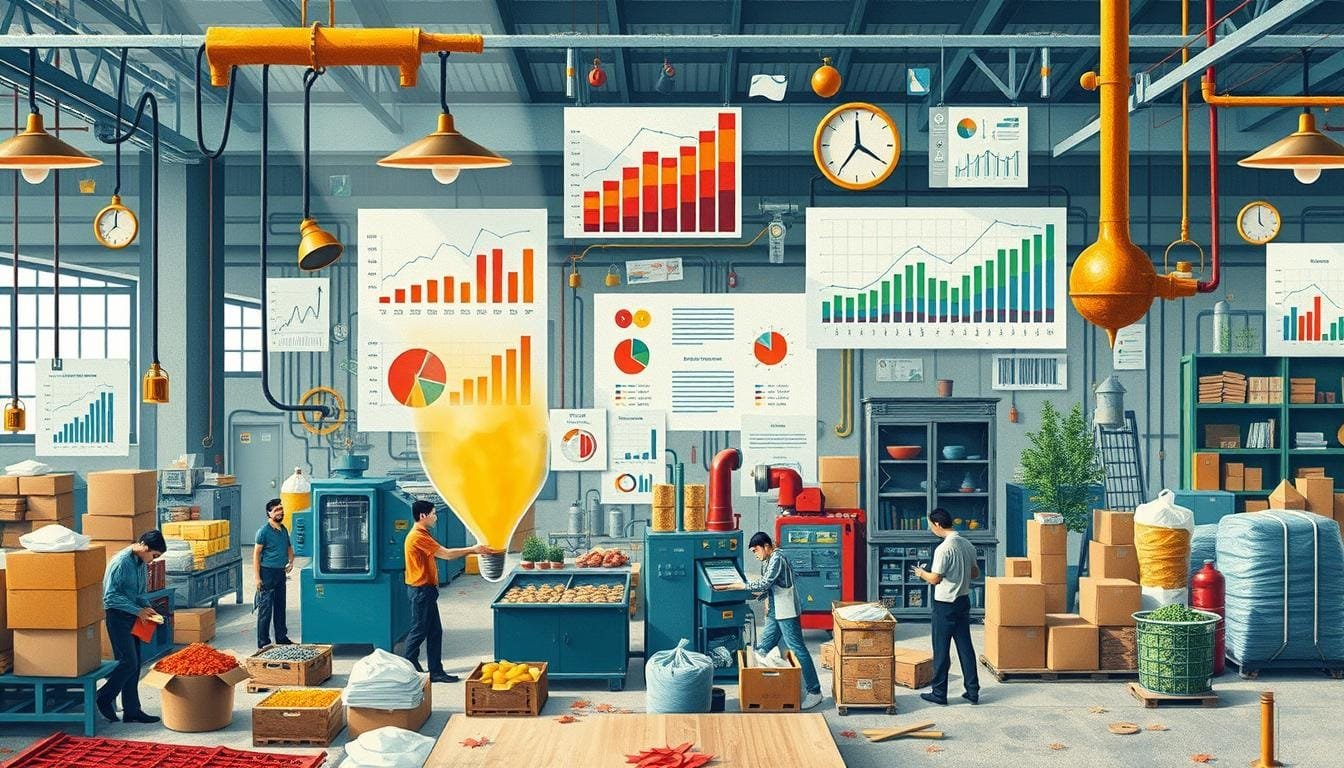Have you wondered how societies decide what to make with limited resources? Welcome to our easy guide on economic production. Here, we’ll explore how decisions are made in production.
Scarcity means we can’t have everything we want, making choices tough. This guide helps you understand how economies decide what to use their resources for. It talks about the types of resources and how different economic systems use them.
We’ll look into how things are made, how prices help make choices, and how different economies affect production. You’ll learn how economic principles impact our world.
Key Takeaways
- Scarcity requires tough choices on how to use resources.
- There are four main resources: natural, human, capital, and entrepreneurship.
- Opportunity cost is what you give up when you choose something else.
- Prices come from supply and demand working together.
- Economic systems—traditional, free market, command, mixed—help decide who gets what resources.
- The U.S. has a mixed economy, with both free market and government roles.
Understanding Economic Resources
Economic resources are key in making goods and services. They include land, labor, capital, and entrepreneurial skills. It’s important to know the different types and the roles they play. This helps tackle economic scarcity and boost production.
Types of Resources
Each type of economic resource has a special role in the economy:
- Land: Covers all natural resources like trees, livestock, and water. Considering the U.S. is 3,794,101 square miles, we see how scarce land is.
- Labor: This is about people’s work, both physical and mental. In 2016, over 158 million people were working in the U.S., showing labor’s vast scale.
- Capital: This includes items like machines and buildings used in making products. It’s different from financial capital.
- Entrepreneurship: This is about spotting profit chances, organizing resources, and taking risks. It’s key for innovation and economic growth.
Resource Allocation and Scarcity
Resource allocation means spreading out resources for different uses to combat economic scarcity. Scarcity happens when we want more goods and services than are available. The way we handle this imbalance depends on opportunity costs and what we value as a society.
For example, how resources are allocated affects businesses and people alike. Companies need to use their resources wisely to produce more and meet consumer demand. Because of scarcity, economic goods must be priced to ration them, underscoring the importance of managing resources well for economic success.
The interaction between various economic resources and how they’re allocated is crucial. It shapes our economic systems, affecting wealth and growth in different areas.
| Resource Type | Examples | Impact on Production |
|---|---|---|
| Land | Natural resources like minerals, soil, water | Provides essential raw materials |
| Labor | Human services, both physical and intellectual | Critical for operational processes |
| Capital | Machinery, tools, buildings | Boosts productivity and efficiency |
| Entrepreneurship | Innovation, risk-taking | Fuels economic growth and development |
Key Factors Influencing Production Choices
In the world of economics, many factors shape our decisions. These factors include how scarce resources are and the need for efficient allocation. We aim to meet various needs and desires. Grasping these factors helps us make choices that use resources well. This is essential for economic growth and stability.
Opportunity Cost
Opportunity cost is a big factor when we talk about production choices. It’s about the value of what you give up by choosing one option over another. In deciding how to use resources, considering opportunity cost is key.
Let’s say a business has to choose how to use its labor. Using more workers to make smartphones means making fewer laptops. This shows in places with lots of skilled workers. Their choice on how to use labor boosts productivity and economic health.
The Role of Price and Incentives
Pricing is crucial in economics. It helps guide how choices are made in production. Supply and demand affect prices, which in turn signal how to use resources.
For example, the ISM Manufacturing Index looks at manufacturing production. If the cost of raw materials goes up, businesses may find cheaper options. They might also invest in new tech to stay profitable. After the 2008 crisis, China’s investments in robots made it a leader in the robot market.
During economic growth, companies often spend more on new equipment. But in tough times, they might cut back. This shows how prices and incentives can change investment and production plans.
| Factor | Impact on Production Choices |
|---|---|
| Opportunity Cost | Influences trade-offs and resource allocation decisions, affecting the range and quantity of goods produced. |
| Price and Incentives | Guides producers on where to allocate resources and investment, impacting production levels and focus areas. |
| Economic Cycles | Alters capital expenditure patterns in response to economic expansion or contractions, modifying production scale. |
In short, factors like opportunity cost and price significantly influence production choices. Knowing these factors helps us understand and manage the complex world of economic choices and resource use.
How will it be Produced in Economics
In economics, producing goods involves using resources like land, labor, and capital. These elements combine in the economic production process to make finished products. They meet what people want to buy. This mix affects a country’s GDP. It’s key to look at how these parts work together to keep the economy strong. Markets make and share money by making goods better and cheaper. This ups production through smart use of resources.

The Production Process
Production efficiency is about getting the most from what you put in. If you use resources to make 100 things but get 60, your efficiency is 60%. New technology has made making things faster and cheaper. This change started with the Industrial Revolution. How you manage resources can make you more or less efficient.
For example, China’s farms got way more productive after 1978. They changed from a controlled economy to one that rewards farmers. But, in some places, too many rules and set prices make things slow and less productive.
Consumer Preferences and Production Decisions
What people want to buy greatly affects what is made. This balance of needs, wants, and making things ensures resources are used right. When things are better and cheaper, everyone wins. Consumers get more for less, and this boosts making things over time.
Everyone involved, from buyers to sellers, helps the economy by encouraging competition. This makes things better and more efficient. In the U.S., spending like the 13.5% on social services in 2011 shows how buying, making, and economic health connect.
Economic Systems and Their Impact on Production
When we look at the world’s economic systems, we find different ways to solve key questions. These include what to produce, how to create things, and who should get them. Traditional, command, and market economies affect how societies make and share goods.

Traditional economies stick to old ways and practices to decide on production. They are steady and keep cultural habits alive. Yet, they may slow down innovation and economic growth. Production relies on ancient customs instead of modern methods.
On the contrary, command economies have everything planned by the government. Places like the Soviet Union, North Korea, and Cuba use this system. It allows for big projects like the Great Wall of China to be built. However, these economies often face inefficiency and don’t meet consumer needs well.
Market economies, seen in the United States and Singapore, operate on supply and demand. Here, private people or companies own the production resources. This competition leads to new inventions and efficient ways to make things. The many buyers and sellers keep the market balanced without letting anyone set all the prices.
Most countries have mixed economies, taking bits from command and market systems. For example, the U.S. mostly has a market system but still has government involvement in areas like health and education. In these economies, governments help make laws, create public goods, and step in when the market fails.
We can summarize the big differences between these economic systems like this:
| Economic System | Ownership of Resources | Decision-Making | Characteristics |
|---|---|---|---|
| Traditional Economy | Based on customs and traditions | Tribal/community leaders | Stability, lack of innovation |
| Command Economy | Government-owned | Centrally planned | Large-scale mobilization, inefficiency |
| Market Economy | Privately owned | Market-driven | Innovation, competition |
| Mixed Economy | Combination of private and government | Both market and government | Balance of efficiency and public welfare |
In conclusion, knowing about economic systems helps us understand how they shape production and economies. Each system manages resources and makes decisions in its own way. This profoundly influences how goods are made and shared in a society.
Characteristics of Major Economic Systems
The structure and function of different economic systems vary worldwide. We explore four main types: traditional economic systems, free market economies, command economies, and mixed economies. It’s crucial to understand how they impact production, resource sharing, and decision-making.
Traditional Economy
Traditional economies are mostly in rural parts of developing countries. They rely on farming and traditional means to make money. These places often have scarce resources, making it hard to produce extra goods.
Free Market Economy
Free market economies grow fast when the government doesn’t interfere much. Although they don’t fully exist, they operate on supply and demand with little control. Yet, governments still step in to keep markets fair and stop monopolies.

Command Economy
Command economies put the government in charge of economic decisions. This setup is common in communist countries. The government manages important resources while the public may control less vital areas like farming.
Mixed Economy
Mixed economies are found worldwide, especially in developed nations like the USA. They mix market and government controls. Industries are mainly private, but the government handles crucial services. Balancing market freedom and government regulation is key but can be difficult.
| Economic System | Key Characteristics | Advantages | Challenges |
|---|---|---|---|
| Traditional Economy | Based on customs, bartering | Stability, sustainability | Limited growth, scarce resources |
| Free Market Economy | Minimal government interference | High growth potential, innovation | Market failures, income disparity |
| Command Economy | Centralized government control | Resource allocation, equality | Efficiency issues, lack of freedom |
| Mixed Economy | Combination of market and command | Balanced growth, regulated markets | Regulatory challenges, mixed results |
Each economic system, including traditional, free market, command, and mixed economies, has unique aspects. They show different ways countries manage their economies. Studying them helps us understand the vast economic diversity worldwide.
Conclusion
Throughout our journey across different economic systems, we’ve seen the link between production and the economy. Knowing how limited resources are used is key in understanding production dynamics. Our guide has shown how economic choices have lasting impacts on society.
The battle between scarce resources and endless desires requires economies to decide on production matters. These decisions are influenced by what society values, government actions, and market dynamics. Events like the Great Recession show how vital these factors are.
Opportunity cost is also crucial in making economic decisions. It helps in understanding the trade-offs, like choosing between studying further or working. Our findings highlight the importance of data in making wise economic choices. Together, these elements give us a deep look into the factors that shape how economies function.
FAQ
What are the main types of economic resources?
Economic resources fall into four main categories: natural, human, capital, and entrepreneurship. Natural resources come from the environment. Human resources are people’s labor and skills. Capital includes technology, buildings, and machinery. Entrepreneurship is about starting businesses and innovation.
How does scarcity affect resource allocation?
Scarcity makes societies decide how to use their limited resources. These decisions depend on what benefits are lost by not choosing another option. Society’s values and what it thinks is important also play a role.
What is opportunity cost and why is it important in economics?
Opportunity cost is the value of what you give up by making a choice. In economics, it’s key because it helps in deciding how to use resources wisely. This leads to smarter choices about what we do with what we have.
How do prices and incentives influence economic decisions?
Prices and incentives guide economic choices through supply and demand. High prices suggest a product is wanted or rare, which encourages more production. But, low prices can lead to less production as producers look for better options.
What are the major steps in the production process?
The production process involves three main steps. First, it starts with gathering resources. Then, these materials are turned into finished products. Finally, the products reach consumers. This requires careful planning and using resources effectively.
How do consumer preferences impact production decisions?
Consumer preferences drive what producers make. As tastes change, producers adapt their products to meet these new desires. This affects which services and goods get made.
What are the different types of economic systems?
There are four main economic systems: traditional, command, free market, and mixed. They each answer what, how, and for whom to produce in different ways. This affects their efficiency, fairness, and level of innovation.
How does a traditional economy function?
A traditional economy is guided by culture and history. It relies on farming, hunting, and gathering. Things are done as they’ve always been, which provides stability but little growth.
What characterizes a free market economy?
In a free market economy, private ownership and market forces reign. There’s little government interference. This promotes growth and choice but can also cause inequality and market issues.
What is the role of government in a command economy?
The government controls everything in a command economy. It decides what to make, the prices, and who gets what. The goal is fairness, but it often struggles with efficiency and innovation.
What distinguishes a mixed economy?
A mixed economy blends market and government control. It has both private and public sectors. The idea is to get the best of efficiency and fairness while providing social welfare.
